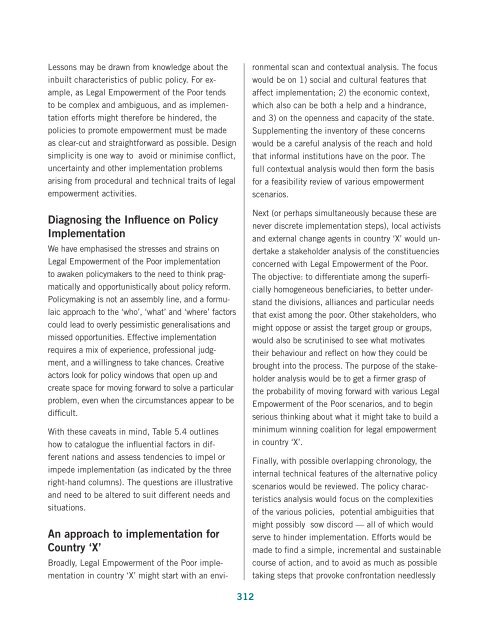Download the file - United Nations Rule of Law
Download the file - United Nations Rule of Law
Download the file - United Nations Rule of Law
You also want an ePaper? Increase the reach of your titles
YUMPU automatically turns print PDFs into web optimized ePapers that Google loves.
Lessons may be drawn from knowledge about <strong>the</strong>inbuilt characteristics <strong>of</strong> public policy. For example,as Legal Empowerment <strong>of</strong> <strong>the</strong> Poor tendsto be complex and ambiguous, and as implementationefforts might <strong>the</strong>refore be hindered, <strong>the</strong>policies to promote empowerment must be madeas clear-cut and straightforward as possible. Designsimplicity is one way to avoid or minimise conflict,uncertainty and o<strong>the</strong>r implementation problemsarising from procedural and technical traits <strong>of</strong> legalempowerment activities.Diagnosing <strong>the</strong> Influence on PolicyImplementationWe have emphasised <strong>the</strong> stresses and strains onLegal Empowerment <strong>of</strong> <strong>the</strong> Poor implementationto awaken policymakers to <strong>the</strong> need to think pragmaticallyand opportunistically about policy reform.Policymaking is not an assembly line, and a formulaicapproach to <strong>the</strong> ‘who’, ‘what’ and ‘where’ factorscould lead to overly pessimistic generalisations andmissed opportunities. Effective implementationrequires a mix <strong>of</strong> experience, pr<strong>of</strong>essional judgment,and a willingness to take chances. Creativeactors look for policy windows that open up andcreate space for moving forward to solve a particularproblem, even when <strong>the</strong> circumstances appear to bedifficult.With <strong>the</strong>se caveats in mind, Table 5.4 outlineshow to catalogue <strong>the</strong> influential factors in differentnations and assess tendencies to impel orimpede implementation (as indicated by <strong>the</strong> threeright-hand columns). The questions are illustrativeand need to be altered to suit different needs andsituations.An approach to implementation forCountry ‘X’Broadly, Legal Empowerment <strong>of</strong> <strong>the</strong> Poor implementationin country ‘X’ might start with an environmentalscan and contextual analysis. The focuswould be on 1) social and cultural features thataffect implementation; 2) <strong>the</strong> economic context,which also can be both a help and a hindrance,and 3) on <strong>the</strong> openness and capacity <strong>of</strong> <strong>the</strong> state.Supplementing <strong>the</strong> inventory <strong>of</strong> <strong>the</strong>se concernswould be a careful analysis <strong>of</strong> <strong>the</strong> reach and holdthat informal institutions have on <strong>the</strong> poor. Thefull contextual analysis would <strong>the</strong>n form <strong>the</strong> basisfor a feasibility review <strong>of</strong> various empowermentscenarios.Next (or perhaps simultaneously because <strong>the</strong>se arenever discrete implementation steps), local activistsand external change agents in country ‘X’ would undertakea stakeholder analysis <strong>of</strong> <strong>the</strong> constituenciesconcerned with Legal Empowerment <strong>of</strong> <strong>the</strong> Poor.The objective: to differentiate among <strong>the</strong> superficiallyhomogeneous beneficiaries, to better understand<strong>the</strong> divisions, alliances and particular needsthat exist among <strong>the</strong> poor. O<strong>the</strong>r stakeholders, whomight oppose or assist <strong>the</strong> target group or groups,would also be scrutinised to see what motivates<strong>the</strong>ir behaviour and reflect on how <strong>the</strong>y could bebrought into <strong>the</strong> process. The purpose <strong>of</strong> <strong>the</strong> stakeholderanalysis would be to get a firmer grasp <strong>of</strong><strong>the</strong> probability <strong>of</strong> moving forward with various LegalEmpowerment <strong>of</strong> <strong>the</strong> Poor scenarios, and to beginserious thinking about what it might take to build aminimum winning coalition for legal empowermentin country ‘X’.Finally, with possible overlapping chronology, <strong>the</strong>internal technical features <strong>of</strong> <strong>the</strong> alternative policyscenarios would be reviewed. The policy characteristicsanalysis would focus on <strong>the</strong> complexities<strong>of</strong> <strong>the</strong> various policies, potential ambiguities thatmight possibly sow discord — all <strong>of</strong> which wouldserve to hinder implementation. Efforts would bemade to find a simple, incremental and sustainablecourse <strong>of</strong> action, and to avoid as much as possibletaking steps that provoke confrontation needlessly312
















